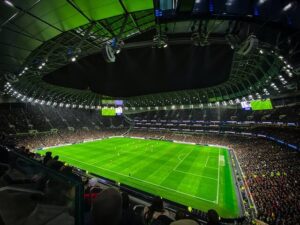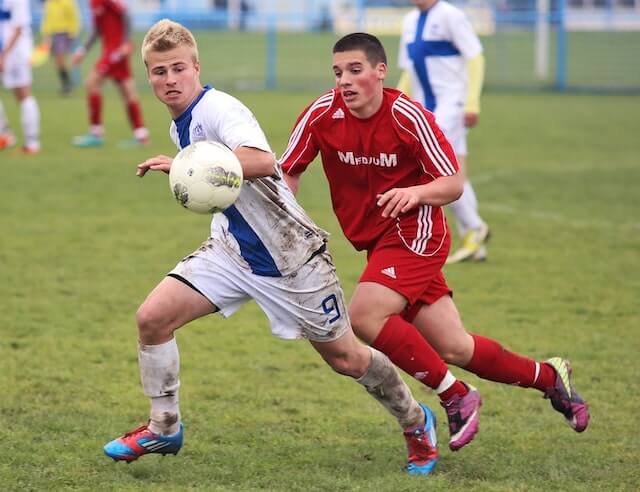江別野幌の英語教室アリスターです。
前回のサッカーの起源イギリスからレポートの(前編)に引き続き後編をお届けいたします。
世界中で親しまれるサッカー その起源と歴史(後編)
(For English leaners 英語原文はこちら
英語学習者の方は先に英文を読んで後で日本語訳を読んでみてください。
日本語は読みやすい様に多少意訳しています。
レベル:高校生程度)
【サポーターになることで何かに属しているという安心感】
サッカーは、世界中の一般の労働者にとってお気に入りのスポーツになりました。
(サッカーに参加すること、チームをサポートする事は)工業都市や都市部の人々に、
コミュニティの感覚と、自分自身や家族以外の何かに属しているという感覚を与えるのに役立ちました。
【何世代も受け継がれる熱狂的サポーター】
これにより、何世代にもわたって家族に受け継がれてきた、
激しい、ほとんど部族的な忠誠心が生まれました。
これは、多くの場合「ダービー※」と呼ばれる、大勢の人が集まる地元の対戦で明らかです。

最も有名なのは、スペインのバルセロナVSレアル マドリード (「エル クラシコ」)、スコットランドのグラスゴーのセルティックVSレンジャーズ (「オールド ファーム」)、イングランドのリバプールVSエバートン、アルゼンチンのブエノスアイレスのリバー プレートVSボカ ジュニアーズです。
※ダービー:ある条件をもつクラブチーム同士の試合
【熱狂的サポーターがもたらした歴史的悲劇】
悲しいことに、これらの大群衆は、世界中で何度も悲劇を引き起こしてきました。
最悪の記録は 1964 年のペルーで、328 人が死亡しました。
参照:「エスタディオ・ナルシオの悲劇」(Wikipedia)』
通常、これらの悲劇は、適切な設備のないスタジアムで出入りの人が多すぎる時に発生しています。これらの悲劇の後 (1989 年にイングランドのヒルズボロ スタジアムで 96 人が死亡したとき) 、英国政府は法律を変更し、トップレベルのサッカーのすべてのスタジアムにすべての観客用の座席と適切な安全規則を設けることを義務付けました。

これにより、国中に新しいスタジアムを建設するために巨額の投資が行われ、サッカーの試合に新しい雰囲気を生み出す事に役立ちました。
今日では、より多くの家族層が試合を観戦し、サポーター グループ間の暴力は減少しています。
【サッカーは巨額のお金が動くビジネスへと成長】
同時に、より多くの試合をテレビで生中継する事により、サッカークラブに巨額の資金が流れ込みました。テレビ会社は、ゲームを放映する権利に喜んで何百万ドルも支払ってきました。
なぜなら、サッカーの試合は大勢の視聴者を引きつけ、より多くの広告時間を販売できるからです。
この事により、主要クラブ間の選手の移籍金が天文学的に上昇しました。
イングランドで 100 万ポンド(現在の円で5億円以上)で移籍した最初のサッカー選手は、1979 年のトレバー フランシスでした。
今日、トップ プレーヤーの移籍金は 1 億ポンド(160億円)を超える場合があります。

多くの国では、トップクラスのサッカーの試合を観戦するための費用が高額になり、ビッグチームには世界中の選手が含まれるようになりました。
その結果、ビッグチームは地元のコミュニティとそれほど密接に結びついていませんが、依然として多くの人々の忠誠心を指揮しており、試合の日にはスタジアムは満員になります。
【貧富の差にかかわらず繁栄し続けているサッカー】
同時に、サッカーはあらゆるレベルで盛んになり続けています。

子供たちのグループが荒れ地でボールを蹴り回す事から、 メッシ率いるアルゼンチンがカタールの数百万ドルのスタジアムにて全世界の何十億もの視聴者の前でワールド カップを制覇することまで、どちらも本当に「美しいゲーム」と言えるでしょう。
【英語原文】
Football became the favourite sport of ordinary working people around the world. It helped to give people in industrial towns and cities a feeling of community and a sense of belonging to something outside themselves and their families.
This created fierce, almost tribal loyalties, which were passed down through families for generations. This can be seen most clearly in some of the local contests – often described as “derbies” – which attract huge crowds.
Some of the most famous are: Barcelona and Real Madrid (“El Clasico”) in Spain, Celtic and Rangers (”The Old Firm”) in Glasgow, Scotland, Liverpool and Everton in England, River Plate and Boca Juniors in Buenos Aires, Argentina. This created fierce, almost tribal loyalties, which were passed down through families for generations.
This can be seen most clearly in some of the local contests – often described as “derbies” – which attract huge crowds. Some of the most famous are: Barcelona and Real Madrid (“El Clasico”) in Spain, Celtic and Rangers (”The Old Firm”) in Glasgow, Scotland, Liverpool and Everton in England, River Plate and Boca Juniors in Buenos Aires, Argentina.
Sadly, these huge crowds have led to disasters on a number of occasions around the world. The worst recorded was in Peru in 1964, when 328 people died. Usually these tragedies have occurred because of too many people trying to enter or leave a stadium which did not have proper safety facilities.
After one of these events – at Hillsborough stadium in England in 1989, when 96 people died – the British Government changed the law to require that all stadiums for top level football must have seats for all spectators and proper safety regulations. This led to enormous investment of money to build new stadiums around the country and helped to produce a new atmosphere at football matches. Nowadays, many more families attend games, and there is less violence between different groups of supporters.
At the same time, huge amounts of money have flowed into football clubs because of the decision to allow many more matches to be broadcast live on television. The TV companies have been willing to pay many millions of dollars for the right to show games, because they attract large audiences and make it possible to sell more advertising time. One effect of this has been that the fees for the transfer of players between the major clubs have risen astronomically. The first football player to be transferred for £1 million in England was Trevor Francis in 1979. Today, transfer fees for the top players can be over £100 million.
In many countries, it has now become much more expensive to attend a top class football match, and the best teams now include players from all over the world. As a result, the big teams are not so closely identified with their local communities, but they still command the loyalty of great numbers of people, and stadiums are full on match days.
At the same time football continues to flourish at all levels, from a group of children kicking a ball around on a piece of waste ground all the way to Lionel Messi winning the World Cup for Argentina at a multi-million dollar stadium in Qatar, watched by billions of people around the whole world. It is still truly “the beautiful game”
